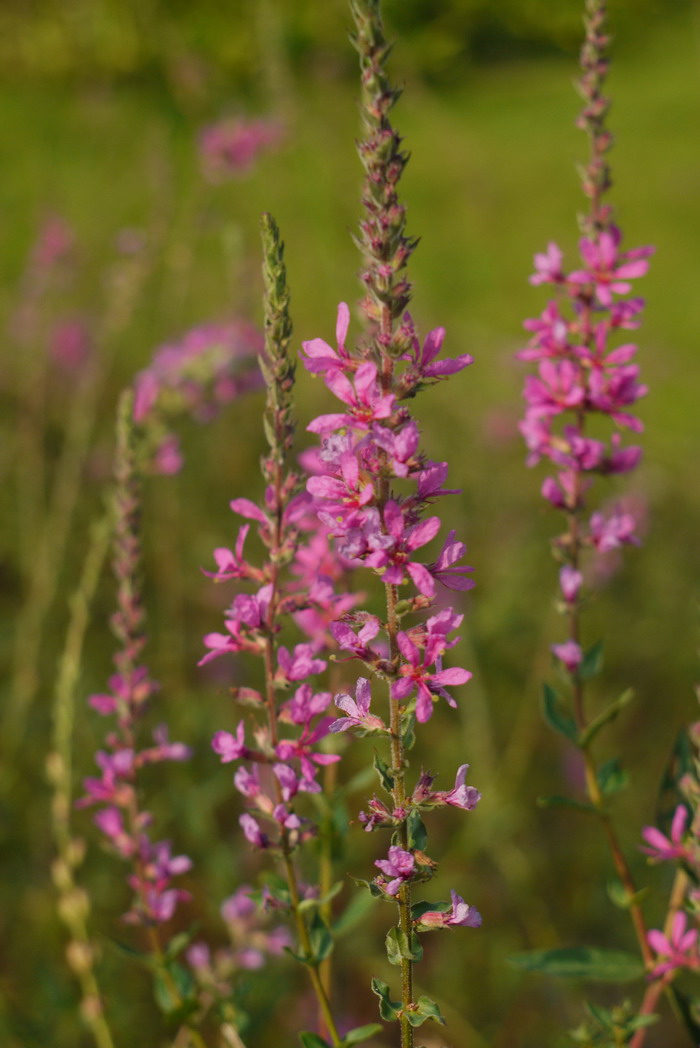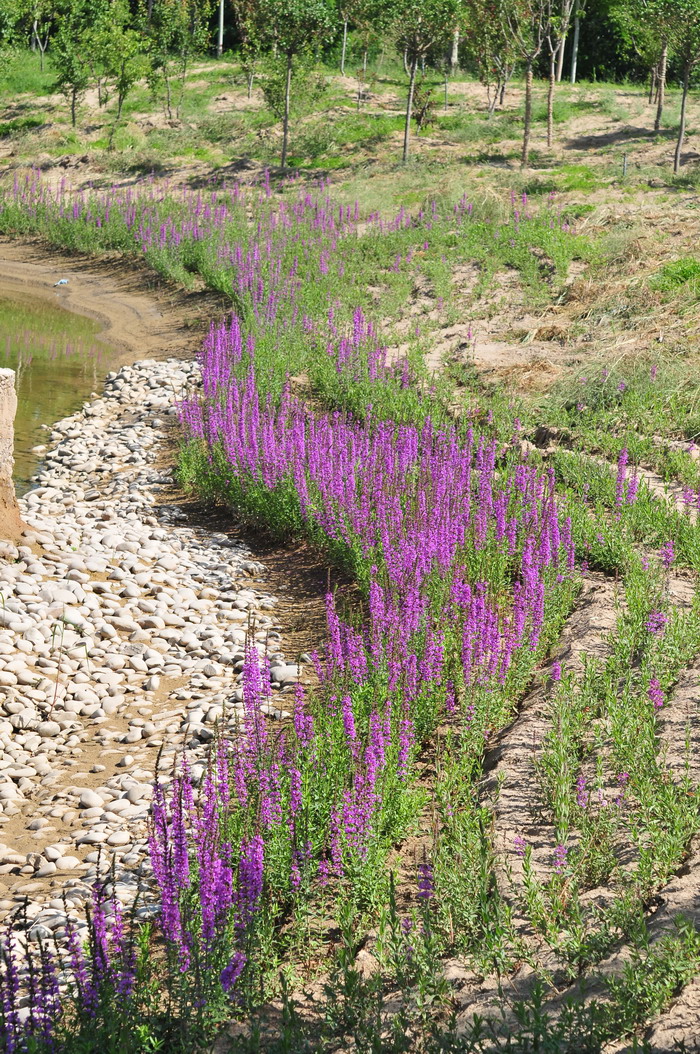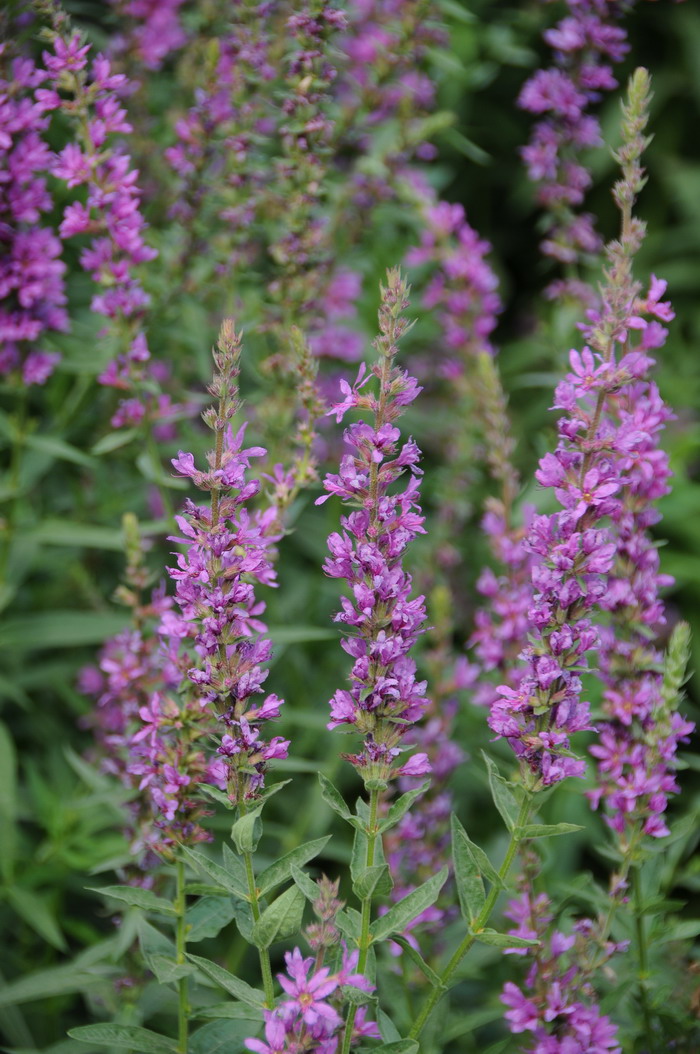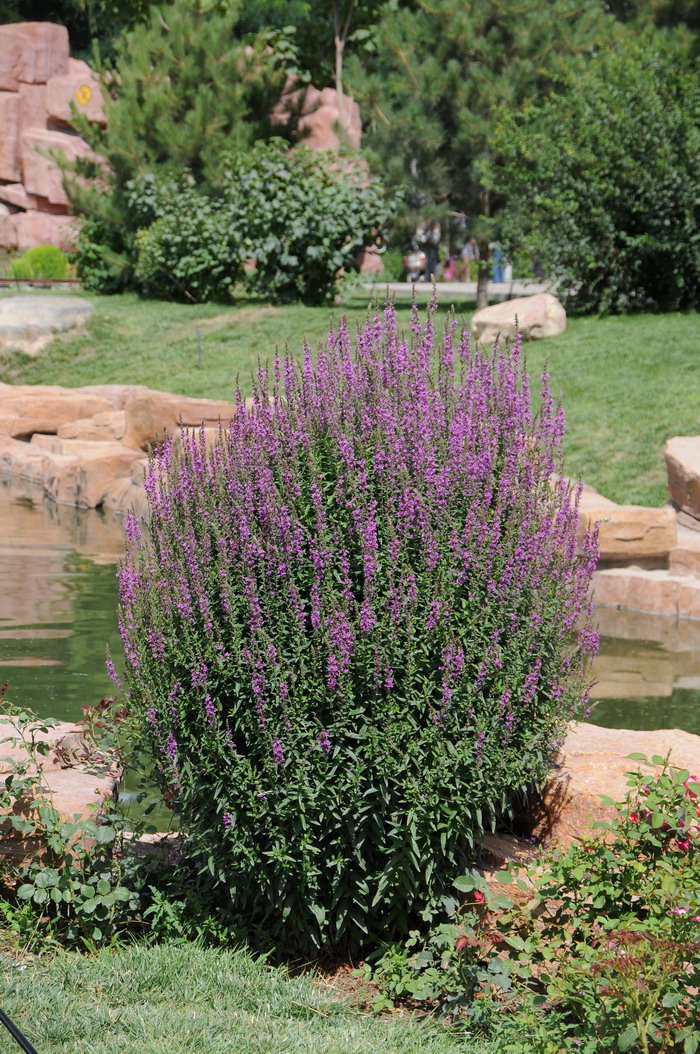千屈菜Lythrum salicaria
中文名(Chinese Name):千屈菜
学名(Scientific Name):Lythrum salicaria L.
英文名(English Common Name):purple loosestrife
别名(Chinese Common Name):水柳
异名(Synonym):Lythrum anceps (Koehne) Mak. Lythrum salicaria var. glabrum Ledeb. Lythrum salicaria var. mairei H. Lév. Lythrum argyi H. Lév. Lythrum salicaria var. anceps Koehne Lythrum salicaria var. vulgare DC. Lythrum salicaria var. gracilior Turcz. Lythrum salicaria var. tomentosum (P. Mill.) DC. Lythrum salicaria subsp. intermedium HARA Lythrum salicaria var. intermedium (Ledeb. ex Colla) Koehne
科属(Family & Genus):千屈菜科(Lythraceae)千屈菜属
形态特征(Description):多年生草本,根茎横卧于地下,粗壮;茎直立,多分枝,高30-10 0厘米,全株青绿色,略被粗毛或密被绒毛,枝通常具4棱。叶对生或三叶轮生,披针形或阔披针形,长4-6(-10)厘米,宽8-15毫米,顶端钝形或短尖,基部圆形或心形,有时略抱茎,全缘,无柄。花组成小聚伞花序,簇生,因花梗及总梗极短,因此花枝全形似一大型穗状花序;苞片阔披针形至三角状卵形,长5-12毫米;萼筒长5-8毫米,有纵棱12条,稍被粗毛,裂片6,三角形;附属体针状,直立,长1.5-2毫米;花瓣6,红紫色或淡紫色,倒披针状长椭圆形,基部楔形,长7-8毫米,着生于萼筒上部,有短爪,稍皱缩;雄蕊12,6长6短,伸出萼筒之外;子房2室,花柱长短不一。蒴果扁圆形。
分布(Distribution):产全国各地,亦有栽培,生于河岸、湖畔、溪沟边和潮湿草地。分布于亚洲、欧洲、非洲的阿尔及利亚、北美和澳大利亚等地。
用途(Use):本种为花卉植物,华北、华东常栽培于水边或作盆栽,供观赏,亦称水枝锦、水芝锦或水柳。全草入药,治肠炎、痢疾、便血;外用于外伤出血。
引自植物志英文版:FOC Vol. 13 Page 282
Lythrum salicaria Linnaeus, Sp. Pl. 1: 446. 1753.
千屈菜 qian qu cai| Lythraceae | Lythrum
Lythrum anceps (Koehne) Makino; L. argyi H. Léveillé; L. intermedium Ledebour ex Colla; L. salicaria var. anceps Koehne; L. salicaria var. glabrum Ledebour; L. salicaria var. intermedium (Ledebour ex Colla) Koehne; L. salicaria var. mairei H. Léveillé.
Perennial herbs or subshrubs, 0.3-1.5 m tall, scabrous or sparsely to densely gray pubescent [or tomentose], sometimes somewhat glabrescent. Stem erect, 4-angled. Leaves opposite or 3-whorled, sometimes alternate toward stem apex, ovate-lanceolate to broadly lanceolate, 2.5-10 × 0.5-1.5 cm, base rounded, truncate, or semiclasping, apex acute to subobtuse. Inflorescences terminal, spicate, 15-35 cm; bracts broadly lanceolate or deltoid-ovate. Flowers in 1- to multi-flowered whorled axillary cymes, shortly pedicellate. Floral tube 5-8 × 1.5-2 mm, 12-ribbed; sepals deltate, 0.5-1 mm; epicalyx segments erect, linear, 1.5-2 mm, much longer than sepals. Petals reddish purple to rose-purple, lanceolate-oblanceolate, 7-10 × 1.5-3 mm. Fl. Jul-Sep, fr. Oct. 2n = 30, 50, 58, 60.
Damp grasslands, banks. Almost throughout China [widespread in northern latitudes worldwide, Afghanistan, India, Japan, Korea, Mongolia, E Russia; N Africa, Europe, North America].
Great variability, especially in degree of indumentum and leaf shape, has led to recognition of many microspecies and infraspecific taxa that are not satisfactorily separated when the species is investigated over its geographic range. Apparent hybridization between Lythrum salicaria and L. virgatum and among the many races of L. salicaria in E Europe and Asia have further confused the taxonomy. Lythrum salicaria is recognized here as a single species with localized variants. Formal names are not recognized for variants within the species until a biosystematic study of the species complex can be made.




(责任编辑:徐晔春)
学名(Scientific Name):Lythrum salicaria L.
英文名(English Common Name):purple loosestrife
别名(Chinese Common Name):水柳
异名(Synonym):Lythrum anceps (Koehne) Mak. Lythrum salicaria var. glabrum Ledeb. Lythrum salicaria var. mairei H. Lév. Lythrum argyi H. Lév. Lythrum salicaria var. anceps Koehne Lythrum salicaria var. vulgare DC. Lythrum salicaria var. gracilior Turcz. Lythrum salicaria var. tomentosum (P. Mill.) DC. Lythrum salicaria subsp. intermedium HARA Lythrum salicaria var. intermedium (Ledeb. ex Colla) Koehne
科属(Family & Genus):千屈菜科(Lythraceae)千屈菜属
形态特征(Description):多年生草本,根茎横卧于地下,粗壮;茎直立,多分枝,高30-10 0厘米,全株青绿色,略被粗毛或密被绒毛,枝通常具4棱。叶对生或三叶轮生,披针形或阔披针形,长4-6(-10)厘米,宽8-15毫米,顶端钝形或短尖,基部圆形或心形,有时略抱茎,全缘,无柄。花组成小聚伞花序,簇生,因花梗及总梗极短,因此花枝全形似一大型穗状花序;苞片阔披针形至三角状卵形,长5-12毫米;萼筒长5-8毫米,有纵棱12条,稍被粗毛,裂片6,三角形;附属体针状,直立,长1.5-2毫米;花瓣6,红紫色或淡紫色,倒披针状长椭圆形,基部楔形,长7-8毫米,着生于萼筒上部,有短爪,稍皱缩;雄蕊12,6长6短,伸出萼筒之外;子房2室,花柱长短不一。蒴果扁圆形。
分布(Distribution):产全国各地,亦有栽培,生于河岸、湖畔、溪沟边和潮湿草地。分布于亚洲、欧洲、非洲的阿尔及利亚、北美和澳大利亚等地。
用途(Use):本种为花卉植物,华北、华东常栽培于水边或作盆栽,供观赏,亦称水枝锦、水芝锦或水柳。全草入药,治肠炎、痢疾、便血;外用于外伤出血。
引自植物志英文版:FOC Vol. 13 Page 282
Lythrum salicaria Linnaeus, Sp. Pl. 1: 446. 1753.
千屈菜 qian qu cai| Lythraceae | Lythrum
Lythrum anceps (Koehne) Makino; L. argyi H. Léveillé; L. intermedium Ledebour ex Colla; L. salicaria var. anceps Koehne; L. salicaria var. glabrum Ledebour; L. salicaria var. intermedium (Ledebour ex Colla) Koehne; L. salicaria var. mairei H. Léveillé.
Perennial herbs or subshrubs, 0.3-1.5 m tall, scabrous or sparsely to densely gray pubescent [or tomentose], sometimes somewhat glabrescent. Stem erect, 4-angled. Leaves opposite or 3-whorled, sometimes alternate toward stem apex, ovate-lanceolate to broadly lanceolate, 2.5-10 × 0.5-1.5 cm, base rounded, truncate, or semiclasping, apex acute to subobtuse. Inflorescences terminal, spicate, 15-35 cm; bracts broadly lanceolate or deltoid-ovate. Flowers in 1- to multi-flowered whorled axillary cymes, shortly pedicellate. Floral tube 5-8 × 1.5-2 mm, 12-ribbed; sepals deltate, 0.5-1 mm; epicalyx segments erect, linear, 1.5-2 mm, much longer than sepals. Petals reddish purple to rose-purple, lanceolate-oblanceolate, 7-10 × 1.5-3 mm. Fl. Jul-Sep, fr. Oct. 2n = 30, 50, 58, 60.
Damp grasslands, banks. Almost throughout China [widespread in northern latitudes worldwide, Afghanistan, India, Japan, Korea, Mongolia, E Russia; N Africa, Europe, North America].
Great variability, especially in degree of indumentum and leaf shape, has led to recognition of many microspecies and infraspecific taxa that are not satisfactorily separated when the species is investigated over its geographic range. Apparent hybridization between Lythrum salicaria and L. virgatum and among the many races of L. salicaria in E Europe and Asia have further confused the taxonomy. Lythrum salicaria is recognized here as a single species with localized variants. Formal names are not recognized for variants within the species until a biosystematic study of the species complex can be made.
(责任编辑:徐晔春)
踩一下[1]

顶一下[10]